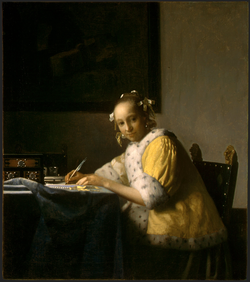Walk: Hood
Distance: 2 miles, Yoga

Gerrit ter Borch (Dutch, 1617-1681), Woman Writing a Letter, 1655, oil on board, 15 3/8" x 13 7/8"
Late in 2017 Ciwt was on her way to the National Gallery in D.C. (or she had her airplane ticket) to see the two Ladies above as well as many more works by the Dutch Masters of Genre Painting. Then there was a huge East Coast blizzard so she missed her opportunity to compare these Ladies and enter 'the conversation' about which painting is best, whether ter Borch was most original, whether Vermeer's Lady is more timeless. And other matters Ciwt really can't get herself to care much about.
To her eye and sensibilities both paintings are absolutely gorgeous images that have rightfully stirred viewers' hearts for centuries and, hopefully, will continue to do so for centuries to come.
Yes, before there was Vermeer, there was ter Borch. Talk about the embarrassment of riches that was the Dutch Golden Age (ca 1581-1672). Of everything!: trade, science, military and culture which included some of the finest and most beloved artists who ever set up their easels. The thriving shipping industry which created enormous wealth for the Dutch citizenry in turn stimulated a booming art market. Scenes of the newly affluent life and leisure appealed most, and artists taught themselves as well as learned from their contemporaries the most effective ways to capture - and sell - that sumptuous tranquility.
Gerrit ter Borch was the first and most influential to turn his talents to genre scenes depicting elegant images of quiet domesticity that also conveyed the inner life of his subjects. This last was particularly inventive. His subdued lighting was exquisite and his skill in reproducing textures of different materials, especially satin, was astounding. He was also the first to paint well-to-do ladies lost in letters and contemplative thought.
Because of ter Borch's innovations, the bustling community scenes favored by previous artists and buyers were almost instantly replaced. His artistic contemporaries took notice of course. One of those was Johannes Vermeer of all people, and to Ciwt these two geniuses living at the same time in close proximity is what is utterly remarkable. Along with the fact that there were several other active artists in Holland at the time who created works remarkably similar in style, subject matter, technique and quality. Talk about a Golden Age.

No comments:
Post a Comment